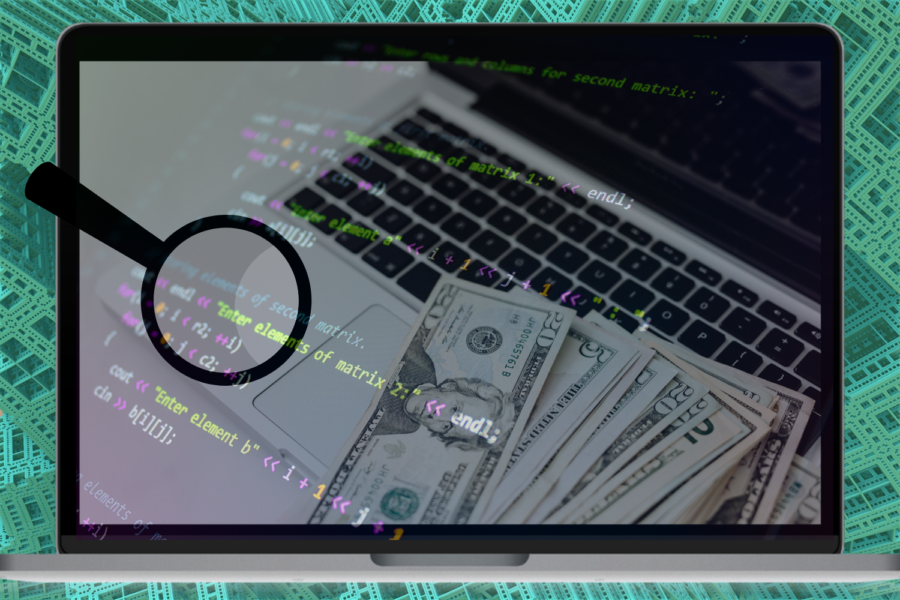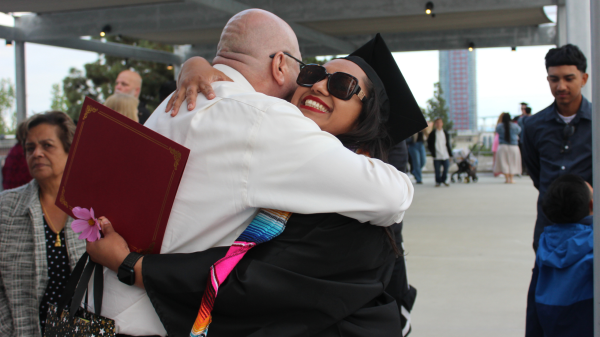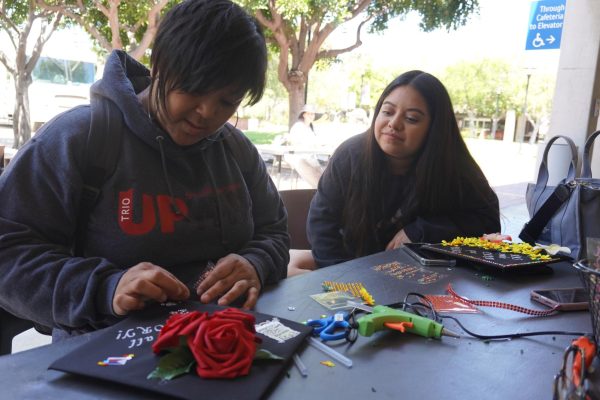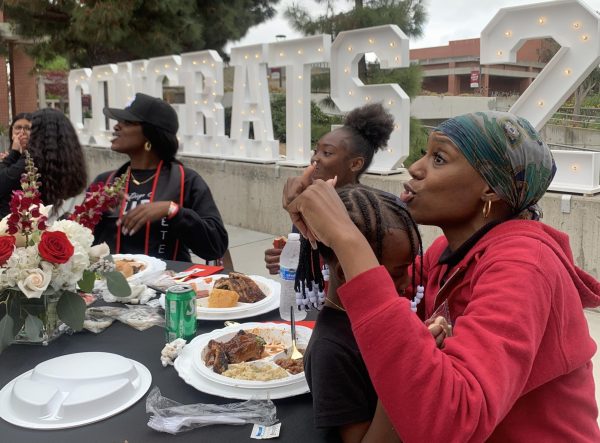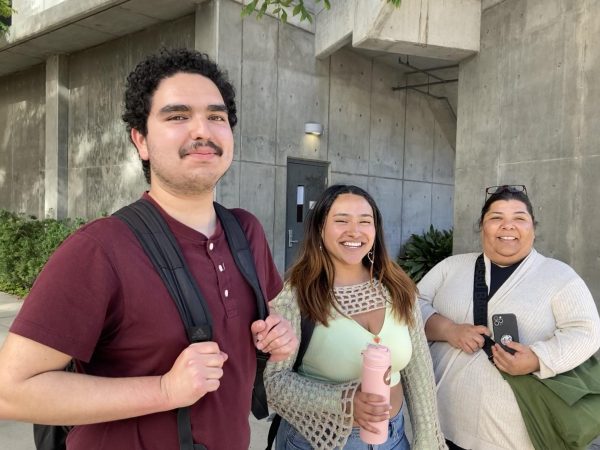SDCCD loses over $100K to ‘bots,’ prevents more fraud with new software
The district prevented the theft of nearly $375K with detection tools, though City College lost thousands in financial aid funds, officials say
Fake students have been targeting San Diego City College during the spring 2022 semester attempting to collect fraudulent financial aid disbursements. Some have been successful and some thwarted by faculty and administrators with the help of software tools. Canva graphic by Kathy Archibald/City Times Media
April 29, 2022
The San Diego Community College District disbursed $101,619 in aid to fraudulent student accounts in February and March and prevented another $373,854 from being stolen, according to Victor DeVore, dean of student services for the district.
City College and the district have turned to electronic and hands-on sleuthing to try to stop the abuse of the financial aid system many students depend on for their education.
“Bot” accounts popped up throughout community colleges over the past year, with faculty and other students reporting the phenomenon at City in February.
In March, the district began to employ new software called IP Quality Score that utilizes algorithms to flag potential fraud, DeVore said.
The software compares an applicant’s IP address, email and phone number to a national database of fraudulent activity such as an email known to have sent spam, or a bot account at another college, he said.
Once a student has been flagged, DeVore said, a hold is put on their account and an email is automatically sent in an attempt to verify the person is a legitimate student.
Marciano Perez, Jr., vice president of student services at City, said sometimes real students get flagged for behavior that may appear suspicious like multiple accounts sharing the same phone number or email address.
Perez cited an example of a parent and child both registering for City classes using the same landline. As soon as their identity can be verified, the hold on the account will be lifted, he added.
Similarly, DeVore said he encountered 50 student accounts registered from the same IP address, which turned out to have a simple explanation – a college application event at the computer lab in a local high school.
However, the vast majority of flagged accounts were identified as fraudulent, either due to a lack of response or further suspicious behavior, DeVore said.
In about 20 cases, the individual attempted to use a fake driver’s license to slip through, he said, one of which claimed to be 5 feet, 70 inches tall.
“Then we had to shift our strategy,” DeVore said, to require either a Zoom or in-person meeting to verify student identities of accounts that appear fraudulent.
Ultimately, the district identified 7,047 fraudulent applications – 2,906 at City College alone – dating back to 2021.
DeVore said he credits the software tool for preventing much of the $373,854 that could have ended up in the hands of fraudsters.
He also credits sharp faculty members, whom he called “our last line of defense.”
However, he said, because the software was introduced in March, some funds got through in the February Pell grant disbursements.
Federal Pell grants are available from the U.S. Department of Education for students with financial need, providing payments that tend to be larger than Higher Education Emergency Relief Fund grants, DeVore said.
HEERF grants are intended for students impacted by the pandemic, such as those given out at City’s 2021 Fall Fest event and other emergency grants offered through the Edquity application.
According to DeVore, the impact – which included $36,666 from City College during the first two months of the spring 2022 semester – came primarily from Pell grant money and, to a lesser extent, HEERF grants.
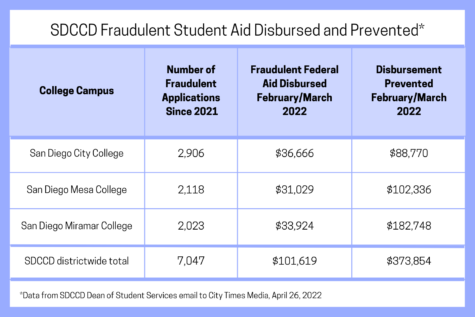
For perspective, City has disbursed over $11 million in HEERF funding to more than 5,000 students, according to the district’s HEERF dashboard.
When money is disbursed to accounts that appear suspicious, the district reports cases to the Office of the Inspector General for the Department of Education, DeVore said.
After that, he said, the status of the case remains unknown to the district until the ED OIG has concluded its investigation.
Overseeing all 116 community college campuses in the state, the California Community Colleges Chancellor’s Office has implemented procedures to address admission fraud, which would be a precursor to enrollment fraud at City, according to a memo sent to administrators.
The CCCCO has also requested fraud data from all colleges they oversee, although 40% of colleges have failed to provide that data, according to an LA Times report in March.
DeVore said he anticipates any April fraud attempts or losses to be included in the district’s next monthly report to the CCCCO on May 10.
He said the CCCCO is requesting the data to justify asking the state legislature for funding to combat the fraud.
Meanwhile, the fake accounts have continued to evolve.
“Fall (of 2021) was pretty quiet – when we started advertising for HEERF,” DeVore said, “but the bot accounts have been changing their game. They’re starting to use different email accounts now. They’re starting to use local San Diego addresses now. So it’s becoming a lot harder for a person to go through (and find them by hand). So that’s why we look at other tools.”
Though the software has been very helpful, DeVore said he has also tried to show up at more faculty trainings, academic senate or professional development meetings to alert professors.
He said he typically sends out emails right before census because that is a “key point” for fraud but hesitates to bombard faculty with emails.
“We get hundreds of emails per day and things get missed,” he added.
Anna Delgado, an assistant professor of fine art at City, agreed that faculty members receive an “unbelievable amount of emails,” although she welcomes information like IT alerts about phishing scams and appreciates that IT responds immediately to these cases.
Delgado said she had 15 “bots” in a class at the beginning of the spring 2022 semester.
Having never previously noticed anything suspicious, “it was nice that my dean responded back immediately with help,” she said.
DeVore said he recommends teachers drop inactive students before the census and reach out if they notice oddities like email addresses with unique patterns, students who don’t reply or participate and those who submit bogus coursework.
Perez added that faculty noticing other unusual academic trends – a class increasing from eight registrations to 40 overnight without an obvious explanation – has helped identify potential fraud.
Even students can notice red flags during online classes, DeVore said, such as another student giving incoherent or unrelated answers or not participating at all.
DeVore also said he anticipates with the return to in-person classes, administrators can focus more on online students, where fraud is more likely.
As HEERF funds wind down, DeVore hopes fraudulent activity will decrease, though he said the software tool now scans all HEERF disbursements before the district sends the information to the Edquity application.
Perez said as the bots get more sophisticated, administrators have to be more diligent.
“Every time we think we’ve patched a hole, a new leak springs up somewhere,” Perez said.
He said he understands the impact on instructors, who think they have a full class and then all of a sudden may not have enough students to justify a class.
The fake accounts also present a challenge in understanding the realities of enrollment numbers at City and the district, which appear to be down 20% for the 2021-2022 school year.
“It’s been tough,” he added.
Perez also said it can be frustrating for students.
“Why all of a sudden do I have to jump through an extra hoop?” he said. “But it really is to protect them and to protect all the other students. Who wants to give out $300,000 worth of aid to students who are not even real?”


